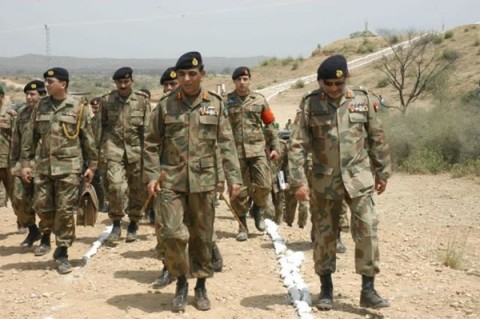Imminent Pakistan Offensive Poses Risks for Obama
The insurgents could respond by targeting the Pakistani army in Waziristan or sending fighters across the porous border into Afghanistan.
Jul 31, 202050.5K Shares1.1M Views
Members of the Pakistani military (ispr.gov.pk)
Very little is clear about the forthcoming Pakistani military push into Waziristan, the rugged, mountainous tribal home base of the Pakistani Taliban and, most likely, Osama bin Laden. When it will begin; what its objectives are; how it will achieve them; and why it will succeed when a 2006 military assault ended in a disastrous ceasefire on the militants’ terms.
That lack of clarity extends to key questions for the U.S. in Pakistan and its associated war in Afghanistan. Will the push drive insurgents across the border? What will it mean for targeting al-Qaeda in Pakistan?
Illustration by: Matt Mahurin
The Obama administration, already involved in what the White House describes as a comprehensive review of strategy for the region, is now looking for the answers. One emerging assumption is that the Pakistani campaign will be protracted, and hardly a replay of this spring’s surprising Pakistani victory in the Swat Valley.
“The Pakistanis have been advertising their upcoming offensive for a while now,” said a U.S. counterterrorism official who insisted on anonymity while discussing sensitive planning issues. “So the terrorists know it’s on the way. They’ve had time to prepare.”
Beginning last week, Pakistani extremists unleashed a wave of violence across the country in anticipation of the offensive, even managing to storm the military staff’s Rawalpindi headquarters far from the tribal areas. On Thursday, another series of coordinated attacks rocked Lahore, the cultural capital of Pakistan. Since October 5, an estimated 150 Pakistanis have died as a result. “The message is to the Pakistani government and it is that news of the Taliban’s demise is greatly exaggerated,” said a former U.S. intelligence official with experience in Pakistan. “They have nothing to lose, they are willing to fight to the death, and they can take that fight to the Pakistani military’s front yard.” At a forum last week at the Council on Foreign Relations with Pakistani Foreign Minister Shah Mahmood Qureshi, the Pakistani ambassador to Washington, Husain Haqqani, good-naturedly brushed off a reporter’s attempt to discuss the campaign.
The army’s invasion, the former intelligence official speculated, may be accelerated by the insurgent attacks. Reuters reported on Wednesdaythat the army was moving an estimated 28,000 troops into position, and some residents of Waziristan quoted by the news service said they saw “soldiers and tanks” approaching. The local government in South Waziristan said Wednesday that up to 90,000 residents have fled the areain preparation for the attack.
Fighting in Waziristan carries implications for two aspects of the Obama administration’s strategy, both of which impact the current White House review. First is whether the arrival of a significant Pakistani ground force will facilitate increased intelligence collection about high-level Taliban or al-Qaeda targets. At present, the Obama administration is considering the contention, advocated by Vice President Biden and the intelligence community, that the CIA’s drone strikes against al-Qaeda operatives in Pakistan more directly support the goal of destroying the terrorist organization than does a counterinsurgency strategy in Afghanistan. The return of Pakistani ground troops into Waziristan, coupled with the intelligence community’s increased focus on the region, might provide an opportunity to facilitate more intense and accurate drone strikes in addition to Pakistani battlefield assaults.
But that is hardly certain. “If the Pakistani military pushes hard into Waziristan, and we’re talking about some very, very rugged terrain here, they might force individual al-Qaeda figures to move,” said the U.S. counterterrorism official. “That, in turn, can make them more vulnerable. It is, at least potentially, a better collection environment. You can’t make hard and fast predictions, though. You just have to be ready to take advantage of any opportunities that might arise, because they won’t last long.”
The second concern for the administration is whether the insurgents will target the Pakistani army in Waziristan or send significant numbers of fighters across the porous border into Afghanistan. “If it looks like they can give their attackers a bloody nose, they’ll stand” and fight, said Thomas Houlahan, director of the military assessment program at the Virginia-based Center for Security and Science think tank. “But if they realize their unit will get overrun, those guys will melt away. They’ll go to a part of the tribal areas where the army isn’t, or they go into Afghanistan and come back later.”
That, in turn, raises questions about the demands the Pakistani campaign will create for a U.S. military effort in Afghanistan that is already considered underresourced by its commander, Gen. Stanley McChrystal, at a time when President Obama is considering a request for tens of thousands more troops. McChrystal’s spokesman, Lt. Col. Tadd Sholtis, said that operations against insurgents in either Pakistan or Afghanistan have “obvious implications for the pro-government forces of both countries,” but declined to address any question about how McChrystal might respond to any potential influx of Taliban fighters fleeing the Pakistani military.
Still, Sholtis said, communications channels remain open with the Pakistanis. “General McChrystal and General Kayani meet regularly in person to discuss a range of issues, including a meeting last week in Pakistan,” Sholtis said, referring to the Pakistani Army’s chief of staff.
Representatives for Gen. David Petraeus, the commander of all U.S. forces in the Middle East and South Asia, who also deals regularly with Kayani, did not respond to repeated requests for comment.
Haider Mullick, a senior fellow at the U.S. Joint Special Operations University, expressed cautious optimism that the Pakistani military would be able to fight the Taliban in the mountainous, rural terrain of Waziristan. The military has assets it did not have in its failed 2006 campaign, he said, including “popular support, high morale, better intel, better [intelligence] cooperation on drones, more precision weapons, two divisions of Army and Frontier Corps combined and at least 1000 special forces, [and] ten gunships.”
But, Mullick said, the effort might still “not make the cut unless at least 2 more divisions move in, more locals are evacuated and there is more ISI [Inter-Services Intelligence]-CIA NATO-Pak military cooperation.” While the army had learned some lessons in counterinsurgency — something Petraeus vouched for in April congressional testimony — it would still need to “spread a strong net, kill the irreconcilables, limit collateral damage, protect civilians who stay behind and leave behind something to work with, [like] basic social and economic infrastructures.”
Houlahan said a key indicator of Pakistani resolve will be whether it uses infantry units from the regular army for the assault. “If it’s primarily a Frontier Corps affair, then it’s clearly not serious in my view. The Frontier Corps is essentially up-armored tribal police,” he said, citing what he said was a Pakistani military tendency to “flatten entire villages with artillery and avoid sending in infantry. … They’ve relied too much on airpower, and have been hesitant to send these units in and force a climactic battle.”

Paula M. Graham
Reviewer
Latest Articles
Popular Articles

